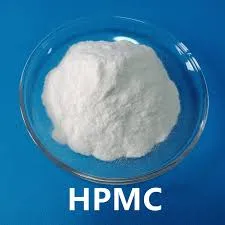
Dek . 20, 2024 12:40 Back to list
Chemical Composition and Structural Analysis of Hydroxypropyl Methylcellulose
The Chemical Structure of Hydroxypropyl Methylcellulose (HPMC)
Hydroxypropyl Methylcellulose (HPMC) is a semi-synthetic polymer derived from cellulose, the most abundant organic polymer on Earth. Recognized for its versatility, HPMC is widely used in various industries, including pharmaceuticals, food, cosmetics, and construction. Its unique chemical structure is pivotal to its properties and applications, making it a subject of interest for both researchers and industry professionals.
The chemical structure of HPMC consists of a cellulose backbone that undergoes modifications through the introduction of hydroxypropyl and methyl groups. Cellulose itself is a linear polysaccharide made up of β-D-glucose units linked by β(1→4) glycosidic bonds. This arrangement provides cellulose with high tensile strength and stability. However, pure cellulose is not soluble in water, which limits its applications. The derivatization of cellulose into HPMC enhances its solubility and functionality.
The Chemical Structure of Hydroxypropyl Methylcellulose (HPMC)
The hydroxypropyl modification involves the substitution of some hydroxyl groups on the cellulose with hydroxypropyl groups (-OCH₂CHOH-). This reaction introduces hydrophilic properties to the molecule, further enhancing water solubility. The hydroxypropyl groups provide the polymer with additional functional characteristics, such as improved gel-forming abilities and thermal stability.
chemical structure of hpmc

The specific ratio of hydroxypropyl to methyl groups in HPMC creates a variety of grades, each tailored for specific applications. For instance, HPMC with a higher degree of hydroxypropyl substitution tends to exhibit better emulsifying and thickening properties, making it an excellent choice for pharmaceutical formulations. In contrast, HPMC with a higher degree of methyl substitution is often utilized in construction materials due to its water retention and workability characteristics.
One of the most notable features of HPMC is its ability to form gels and viscous solutions. When dispersed in water, HPMC expands and swells, forming a gel-like network that can encapsulate other substances. This property is crucial in the pharmaceutical industry, where HPMC is employed as a binder in tablet formulations, controlling the release of active ingredients. Additionally, its viscosity modulation properties allow for the creation of stable emulsions and suspensions in various cosmetic products.
In the food industry, HPMC serves as a thickening agent and stabilizer in food products, contributing to texture and mouthfeel. Its ability to retain moisture makes it advantageous in baked goods and dairy products, where it helps maintain freshness and extend shelf life.
In conclusion, the chemical structure of Hydroxypropyl Methylcellulose plays a fundamental role in its multifunctional properties. The modifications through methylation and hydroxypropylation create a polymer that is soluble in water, versatile in application, and highly beneficial across various industries. As research continues into the potential of HPMC, its applications are likely to expand, further solidifying its importance as a key ingredient in numerous formulations.
-
Versatile Hpmc Uses in Different Industries
NewsJun.19,2025
-
Redispersible Powder's Role in Enhancing Durability of Construction Products
NewsJun.19,2025
-
Hydroxyethyl Cellulose Applications Driving Green Industrial Processes
NewsJun.19,2025
-
Exploring Different Redispersible Polymer Powder
NewsJun.19,2025
-
Choosing the Right Mortar Bonding Agent
NewsJun.19,2025
-
Applications and Significance of China Hpmc in Modern Industries
NewsJun.19,2025







